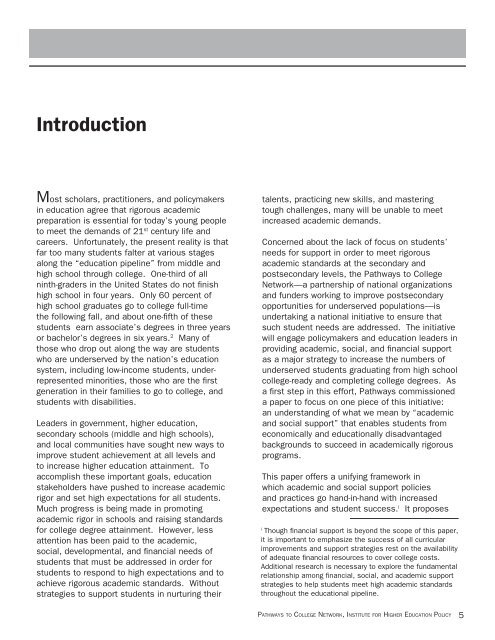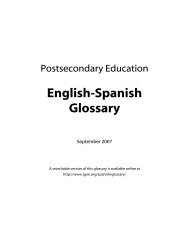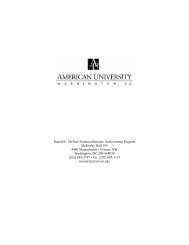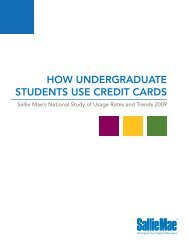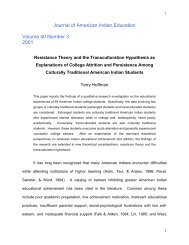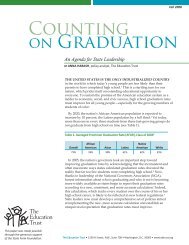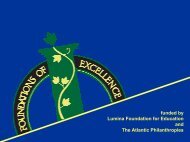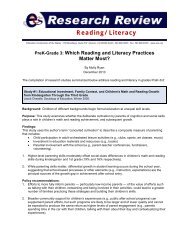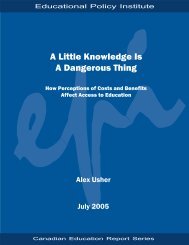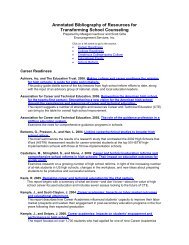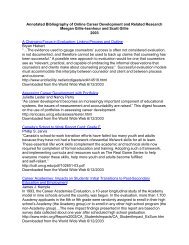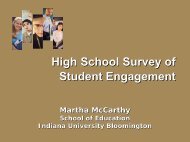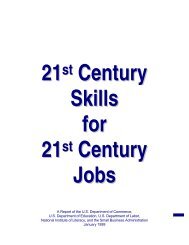Removing Roadblocks to Rigor: Linking Academic and Social ...
Removing Roadblocks to Rigor: Linking Academic and Social ...
Removing Roadblocks to Rigor: Linking Academic and Social ...
Create successful ePaper yourself
Turn your PDF publications into a flip-book with our unique Google optimized e-Paper software.
Introduction<br />
Most scholars, practitioners, <strong>and</strong> policymakers<br />
in education agree that rigorous academic<br />
preparation is essential for <strong>to</strong>day’s young people<br />
<strong>to</strong> meet the dem<strong>and</strong>s of 21 st century life <strong>and</strong><br />
careers. Unfortunately, the present reality is that<br />
far <strong>to</strong>o many students falter at various stages<br />
along the “education pipeline” from middle <strong>and</strong><br />
high school through college. One-third of all<br />
ninth-graders in the United States do not finish<br />
high school in four years. Only 60 percent of<br />
high school graduates go <strong>to</strong> college full-time<br />
the following fall, <strong>and</strong> about one-fifth of these<br />
students earn associate’s degrees in three years<br />
or bachelor’s degrees in six years. 2 Many of<br />
those who drop out along the way are students<br />
who are underserved by the nation’s education<br />
system, including low-income students, underrepresented<br />
minorities, those who are the first<br />
generation in their families <strong>to</strong> go <strong>to</strong> college, <strong>and</strong><br />
students with disabilities.<br />
Leaders in government, higher education,<br />
secondary schools (middle <strong>and</strong> high schools),<br />
<strong>and</strong> local communities have sought new ways <strong>to</strong><br />
improve student achievement at all levels <strong>and</strong><br />
<strong>to</strong> increase higher education attainment. To<br />
accomplish these important goals, education<br />
stakeholders have pushed <strong>to</strong> increase academic<br />
rigor <strong>and</strong> set high expectations for all students.<br />
Much progress is being made in promoting<br />
academic rigor in schools <strong>and</strong> raising st<strong>and</strong>ards<br />
for college degree attainment. However, less<br />
attention has been paid <strong>to</strong> the academic,<br />
social, developmental, <strong>and</strong> financial needs of<br />
students that must be addressed in order for<br />
students <strong>to</strong> respond <strong>to</strong> high expectations <strong>and</strong> <strong>to</strong><br />
achieve rigorous academic st<strong>and</strong>ards. Without<br />
strategies <strong>to</strong> support students in nurturing their<br />
talents, practicing new skills, <strong>and</strong> mastering<br />
<strong>to</strong>ugh challenges, many will be unable <strong>to</strong> meet<br />
increased academic dem<strong>and</strong>s.<br />
Concerned about the lack of focus on students’<br />
needs for support in order <strong>to</strong> meet rigorous<br />
academic st<strong>and</strong>ards at the secondary <strong>and</strong><br />
postsecondary levels, the Pathways <strong>to</strong> College<br />
Network—a partnership of national organizations<br />
<strong>and</strong> funders working <strong>to</strong> improve postsecondary<br />
opportunities for underserved populations—is<br />
undertaking a national initiative <strong>to</strong> ensure that<br />
such student needs are addressed. The initiative<br />
will engage policymakers <strong>and</strong> education leaders in<br />
providing academic, social, <strong>and</strong> financial support<br />
as a major strategy <strong>to</strong> increase the numbers of<br />
underserved students graduating from high school<br />
college-ready <strong>and</strong> completing college degrees. As<br />
a first step in this effort, Pathways commissioned<br />
a paper <strong>to</strong> focus on one piece of this initiative:<br />
an underst<strong>and</strong>ing of what we mean by “academic<br />
<strong>and</strong> social support” that enables students from<br />
economically <strong>and</strong> educationally disadvantaged<br />
backgrounds <strong>to</strong> succeed in academically rigorous<br />
programs.<br />
This paper offers a unifying framework in<br />
which academic <strong>and</strong> social support policies<br />
<strong>and</strong> practices go h<strong>and</strong>-in-h<strong>and</strong> with increased<br />
expectations <strong>and</strong> student success. i It proposes<br />
i<br />
Though financial support is beyond the scope of this paper,<br />
it is important <strong>to</strong> emphasize the success of all curricular<br />
improvements <strong>and</strong> support strategies rest on the availability<br />
of adequate financial resources <strong>to</strong> cover college costs.<br />
Additional research is necessary <strong>to</strong> explore the fundamental<br />
relationship among financial, social, <strong>and</strong> academic support<br />
strategies <strong>to</strong> help students meet high academic st<strong>and</strong>ards<br />
throughout the educational pipeline.<br />
PATHWAYS TO COLLEGE NETWORK, INSTITUTE FOR HIGHER EDUCATION POLICY 5


